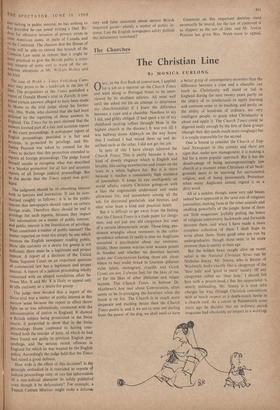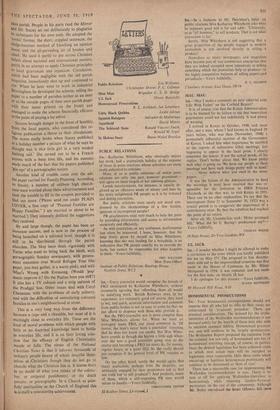The Churches
The Christian Line
By MONICA FURLONG
ONCE, in the first flush of conversion, I applied for a job as a reporter on the Church Times and went along to Portugal Street to be inter- viewed by its ebullient editress. All went well until she asked me (in an attempt to determine my churchmanship) if I knew the difference between a cope and a chasuble. Needless to say I did, and glibly obliged. (I had spent a lot of my childhood sucking toffees through Mass in the highest church in the diocese.) It was not till I was halfway down Aldwych on the way home that I realised I had mixed them up and de- scribed each as the other. I did not get the job.
In spite of this I have always admired the Church Times. This is partly because it has a kind of dowdy elegance which is English and lovable, like eating strawberries and cream on the lawn in a white leghorn hat. But it is more because it reaches a consistently high standard of journalism. It keeps its eye intelligently on world affairs, reports Christian goings-on with a bias the cognoscenti understand and make allowance for, and somewhere among all the ads. for distressed gentlefolk, and birettas, and altar wine beats a kind and practical heart.
But it is difficult to get away from the feeling that the Church Times is a trade paper for clergy- men, and not just any old clergymen but ones of a certain idiosyncratic stripe. Those long, pas- sionate wrangles about vestments in the corre- spondence columns (it really is time we Anglicans consulted a psychiatrist about our vestment- fetish), those intense worries over women priests in Sweden and whether we dissolute laymen make our Communions fasting, those ads. about where to buy wafer bread in fourteen different styles (plain, monogram, crucifix and Greek Cross) are not, I always feel, for the likes.of me, or for the likes of other philistine and vulgar laymen. The Church Times, to borrow Dr. Matthews's bon mot about Convocation, often seems to be re-arranging the furniture when the house is on fire. The Church is in much more desperate and exciting straits than the Church Times paints it, and if we are to save our darling from the power of the dog, we shall need to have a better grasp of contemporary monsters than the difference between a cope and a chasuble can teach us. Christianity will stand or fall in England during the next twenty years partly on the ability of its intellectuals to apply learning and common sense to its teaching, and partly on the ability of hundreds of ordinary, not very intelligent people, to grasp what Christianity is about and apply it. The Church Times could be digested easily enough by the first of these groups (though their diet needs much more roughage) but it is totally impossible for the second.
One is bound to consider the Church of Eng- land Newspaper in this context and there are signs that, under new management, it is making a bid for a more popular approach. But it has the disadvantage of being uncompromisingly low church at a moment when Christians of all back- grounds seem to be yearning for sacramental religion, and of being passionately Protestant when many Anglicans almost regard it as a dirty word.
All of a sudden, though. some very odd beasts indeed have appeared in the tame zoo of religious journalism, making faces at the other animals and smelling powerfully of the jungle. Some of them are 'little magazines' joyfully pulling the bones of religious controversy backwards and forwards between them, and when I have made a more complete collection of these I shall hope to write about them. Some good ones are run by undergraduates. though these seem to be more reverent than is seemly at their age.
But the wildest beast caught alive on recent safari is the National Christian News run by Nicholas Stacey. Mr. Stacey, who is Rector of Woolwich, looks exactly like a clergyman of the 'dear lady' and 'good in parts' variety. (If any clergyman called me 'dear lady.' I should fell him with a prayer-book.) But his appearance is utterly misleading. Mr. Stacey is a man who charges his way through Christian conventions with as much respect as a death-watch beetle in a church roof. As a curate in Portsmouth some years ago he decided that an ordinary parish magazine had absolutely no impact in a working-
class parish. People in his parts read the Mirror and Mr. Stacey set out deliberately to plagiarise its techniques for his own ends. He adopted the comic' format. the short, crippled sentences, the sledge-hammer method of knocking an opinion home, and the all-pervading air of bounce and cheek. He used it partly to put across Christian beliefs about national and international matters, Partly in an attempt to apply Christian principles to local grievances and injustices. Circulation, Which had been negligible with the old parish Magazine, immediately shot up and continued to rise. When he later went to work in industrial Birmingham he developed the scheme, selling the Paper to a number of parishes (either as an inset or as the outside pages of their own parish paper with their name printed on the front) and managed to make the scheme financially efficient to the point of paying a lay editor.
Success brought danger in the form of hostility from the local papers, who considered this re- ligious publication a threat to their circulations. The storm really broke when Stacey published in a holiday number a picture of what he says he thought was 'a nice little girl in a very modest bathing suit.' She turned out to be a French actress with a busy love life, and his enemies made much of the fact that his papers published `Pin-ups' of a pornographic nature.
Another kind of trouble came over the ads. the paper carried for Family Planning. According to Stacey, a number of celibate high church- Men were worried about these advertisements and took the trouble to fill in the coupon provided to find out more. (Please send me under PLAIN COVER, a free copy of "Planned Families are Happy Families." I am married or about to be married.') They intensely disliked the suggestions they received.
By and large though, the paper has been an immense success, and is now in the process of being launched on a national level, though it is still to be distributed through the parish churches. The May issue deals vigorously with Tories who want to bring back the birch, with pornographic Sunday newspapers, with govern- ment meanness over World Refugee Year (the' paper, you may gather, is a warm pink), and with What's Wrong with Evensong. (Would 'pop' Music improve it? Do the Psalms bore you stiff?) It also has a TV column and a strip cartoon of the Prodigal Son. Other issues deal with Caryl Chessman, with the problems of early puberty, and with the difficulties of assimilating coloured families in one's neighbourhood or street.
This is a very long way from the difference between a cope and a chasuble, but most of it is excitingly close to everyday life. These are the kind of moral problems with which people with little or no doctrinal knowledge have to battle in everyday life, and it is on their loving solu- tion that the efficacy of English Christianity stands or falls. The virtue of the National Christian News is that it informs thousands of ordinary people (many of whom describe them- selves as Christians though they do not go to church) what the Christian line is. It leaves them in no doubt of what love thinks of the colour- bar, or corporal punishment, or the death penalty, or pornography. In a Church as pain- fully inarticulate as the Church of England this is in itself a newsworthy achievement.











































 Previous page
Previous page